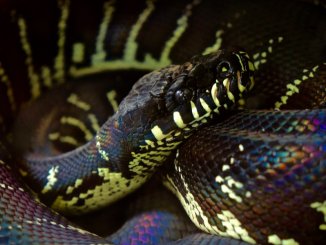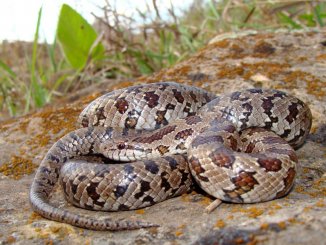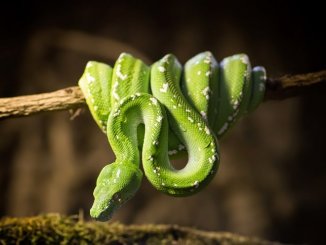The Sonoran gopher snake is beautifully colored with yellow and brown splotches, including a series of stripes on its tail.
It gets its name from its primary habitat, the Sonoran desert. However, it can be found throughout the southwestern United States.
Sonoran gopher snakes are quite common in the wild and have a good temperament, making them a popular choice for a pet.
Sonoran Gopher Snake Overview
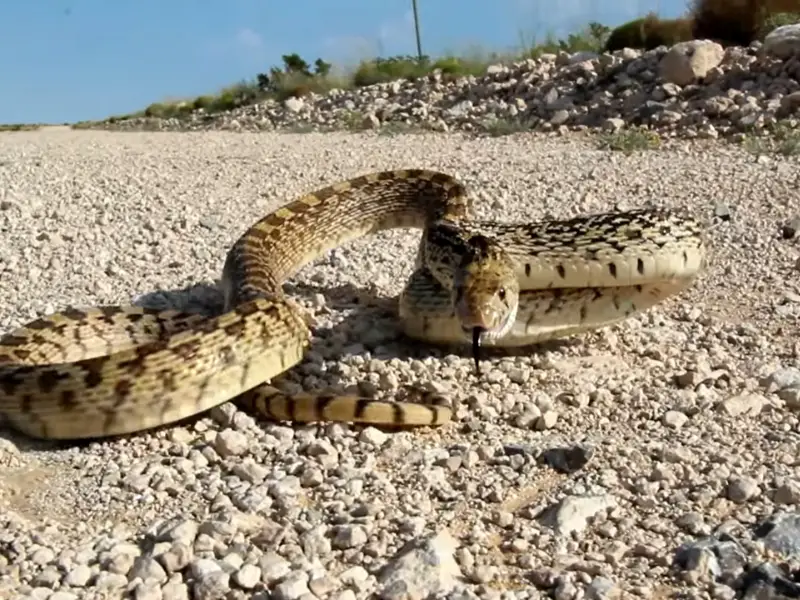
| Common name | Sonoran gopher snake |
| Scientific name | Pituophis catenifer affinis |
| Natural habitat | Southwestern United States. Also found in Texas, Arizona, and northern Mexico. They thrive in a dry desert environment. |
| Adult size | Average adult Sonoran gopher snake measures between 4 - 6 ft in length (121–183 cm). |
| Average lifespan | 15+ years |
| Diet | Small rodents, occasionally birds and eggs. |
| Housing | 4ft x 2ft x 2ft enclosure |
| Experience | Beginner and intermediate |
Origin
The Sonoran gopher snake (Pituophis catenifer affinis) is a snake found predominantly in the United States.
They are very common along the southern rim of the Grand Canyon.
However, you can also find them throughout Arizona, Texas, and northern Mexico.
They thrive in dry, desert-like environments. Because of this, they often brumate in winter to escape the cold.
Appearance And Behavior
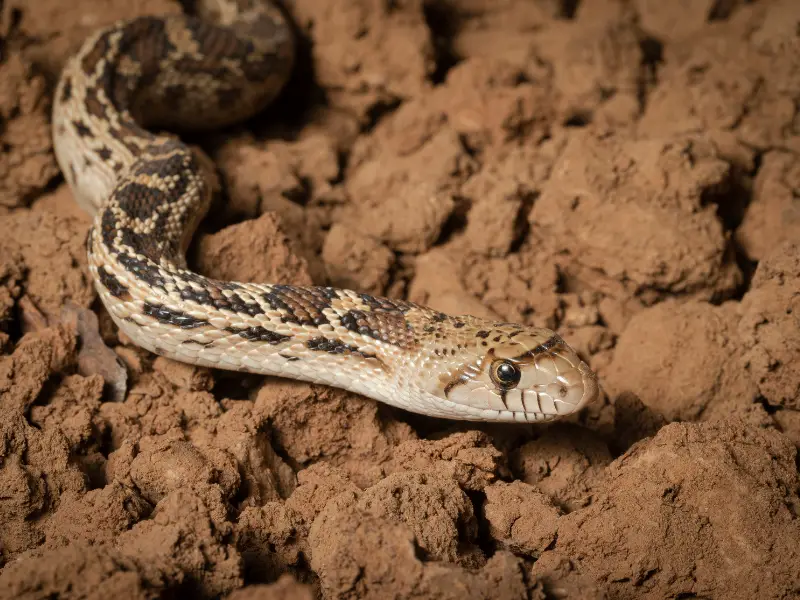
The Sonoran gopher snake has a pattern of yellow and brown spots, with distinctive dark brown bands on its tail.
They also have a yellowish underbelly and smaller spots on their sides.
Because of these coloring and markings, Sonoran gopher snakes can sometimes be mistaken for rattlesnakes.
This is worsened by the fact that they shake their tails when threatened.
People often kill them in the wild, but they are entirely harmless to humans.
The males tend to be smaller than the females. They are also quite bulky, and often described as heavy-bodied.
Size And Lifespan
By adulthood, most grow between 4 and 6 feet in length. In some rare cases, they can even grow to 7 feet.
They can be up to a foot in size when they hatch.
In captivity, your snake should live to be around 12 – 15 years, with the care guidelines set out here.
With proper care, your snake will live a long and happy life.
The oldest known Sonoran gopher snake in captivity lived for 33 years.
So before choosing one of these as a pet, make sure you are ready for a long-term commitment.
Temperament
In general, these snakes are not aggressive and can make good pets if they are handled carefully.
They are often defensive in the beginning, but this is something that tends to go away over time with appropriate care.
When they feel threatened, they can hiss and rattle their tail. However, adults are unlikely to actually bite, provided you are handling them correctly.
Juveniles are feistier and will often nip, but will likely grow out of it with proper handling.
While these are good-natured snakes, it is not recommended to house them together, unless you are breeding them.
They are not aggressive but can be somewhat territorial.
They are smart and very inquisitive. It is important to provide them with mental stimulation, like something to climb.
Because they are very active snakes, they require large enclosures.
Housing A Sonoran Gopher Snake
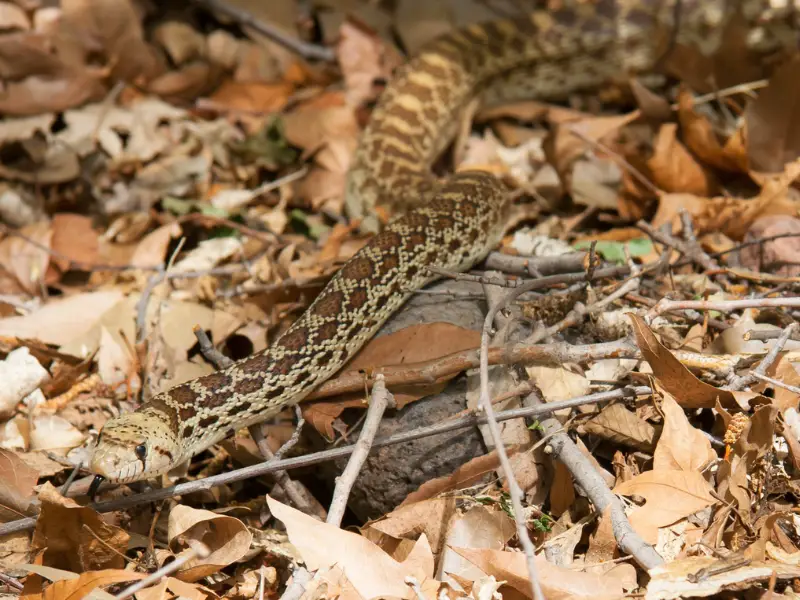
In the wild, Sonoran gopher snakes live in a variety of habitats and are considered quite versatile.
This translates into their needs when in captivity.
They cope well in a variety of enclosures, including reptile terrariums, vivariums, and rack systems.
How you house your Sonoran gopher snake is a matter of preference and paying attention to the individual needs of your specific snake.
Enclosure size
Your snake’s needs will adapt as they grow. Because of this, people often start their juvenile snakes out in a glass aquarium tank of around 10 gallons before moving them into a proper terrarium.
Adult Sonoran gopher snakes need at least a 40-gallon tank, with dimensions of 4ft x 2ft x 2ft.
While this is the minimum requirement, going bigger is better if you can.
Your Sonoran gopher snake will always appreciate more space, and for these snakes, floor space is more important than height.
These snakes are skilled escape artists so it is important to make sure the top of the cage is secure, ideally locked.
Lighting
A Sonoran gopher snake needs light for at least 12 hours a day, and you want to try and mimic natural light as much as possible.
While they don’t require specific lighting, UVB lights are beneficial to their overall health.
This is because it more closely mimics the light of the sun in the wild.
t is important to make sure that their light is either protected or placed outside of the enclosure because they will want to investigate it.
At night, you want to turn off the lights to simulate the outside world.
There should be both full and partial cover from the lighting to allow your snake to thermoregulate.
Temperature And Humidity
It is important to provide your Sonoran gopher snake with both warm and cool areas in its enclosure.
Because snakes are cold-blooded, they rely on external sources to regulate their temperature.
So, you need to provide a cooler area to help your snake thermoregulate, with a hide on both sides.
It is very easy to find a thermometer specifically designed to work in a snake’s enclosure to help you monitor the temperature.
The warm area of the enclosure (where you will place the lighting) should be kept at 85 – 88°F, while the cool side should be 75 – 80°F.
At night, you should lower the temperature to around 72°F.
When it comes to humidity, Sonoran gopher snakes need around 50 – 60% humidity, which you can measure with a hygrometer.
When snakes are shedding, you should increase the humidity. To do this, you can mist the enclosure a few times a day.
When preparing to shed, the scales get dull and the eyes get cloudy.
They are also likely to refuse food when shedding, and this is not a concern. Make sure your cool hide box has damp sphagnum moss.
Substrate And Decoration
When it comes to the substrate of your enclosure, these snakes can tolerate a wide variety of different materials.
Because they often enjoy burrowing, something with loose particles, like beech wood chips, can be a good choice.
This also helps because it does not increase the humidity.
Other options include orchid bark and aspen wood chips. It is vital to avoid cedar or pine chip shavings because they are toxic to snakes.
Also, avoid things like gravel and stones because they are abrasive.
You should have at least 3 inches of the substrate to allow for potential burrowing.
In terms of decoration, there are several functional things to include.
This includes two hides, one at each end so that there is a cool and warm place for the snake to hide.
Other good ideas include a branch to climb for mental stimulation, tubes to slither through, plants for partial cover, and a big basking stone under or near the lighting.
Just make sure the stone doesn’t get too hot.
Cleaning
It is vital that your Sonoran gopher snake has a clean and safe enclosure.
You should regularly spot-clean the areas where your snake has gone to the toilet to make sure that the enclosure remains hygienic.
Keep the water bowl clean to prevent a buildup of bacteria and slime. Give it a good scrub once a week.
Apart from this ongoing cleaning, you should do a deep cleaning of the entire enclosure at least once a month.
In this process, you should thoroughly disinfect the enclosure.
It can be dangerous to use household chemicals in your snake’s habitat.
Use cleaning products specifically designed for snake care or a vinegar water solution.
While cleaning, you can carefully place your snake in any suitably sized tub with air holes, as it is only for a short period of time.
Sonoran Gopher Snake Care
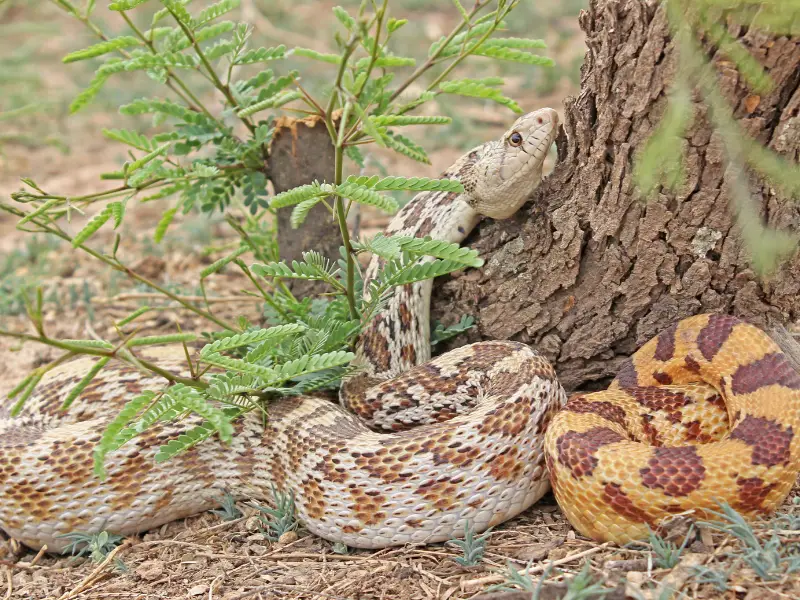
The care of these snakes is fairly simple and straightforward, making them a beginner-friendly snake breed.
However, because of their large size, they may be best for people with intermediate experience.
They don’t have any specific care requirements, besides basic feeding and cleaning.
They are not prone to major health problems and generally have a good temperament.
Food And Water
When it comes to feeding, Sonoran gopher snakes need rodents that do not exceed the girth of the snake at its widest point.
You can start juveniles on smaller rodents and should feed them weekly.
For adult snakes, either feed them a medium rodent weekly or a large rodent every two weeks. Avoid live food, and rather choose frozen rats.
To feed them, offer the food using tweezers to allow them to strike. You can feed them in their enclosure without worry.
Don’t handle them for a few hours before feeding or 48 – 72 hours after.
You want to avoid stressing them before feeding, and handling them after a meal can disrupt digestion and even cause the snake to regurgitate its meal.
The water bowl should be big enough to soak and should be placed on the cool side to reduce humidity on the warm side.
It should also be heavy enough that they can’t knock it over.
Access to clean, fresh water is vital, and you should ideally change out the water every day.
Handling
In the beginning, when you first get your pet, they will be anxious about being handled.
This is not a cause for concern, as you need to let them settle into their new environment first.
Once they seem more comfortable in their enclosure, you can begin to handle them.
Make sure that you are always supporting their body weight when holding them.
Avoid touching their head until you have formed a connection with your snake and it knows that it can trust you or this can make them anxious and jerk suddenly.
You will bond with your snake over time, and most Sonoran gopher snakes enjoy being handled and are very friendly.
Because of their temperament, they make excellent pets.
Common Health Issues
These snakes are hardy and aren’t prone to any specific health conditions.
The main thing to watch out for is a refusal to eat, which could be a sign of illness.
If your snake looks healthy, has shiny scales, and is well-fleshed out, you don’t need to panic.
However, if this continues, take your pet to the vet.
Something else that can occur in all snakes is blister disease, which presents with blisters and bumps under the scales.
This happens when the enclosure is too wet, so monitor the humidity of your enclosure carefully.
On the other hand, watch out for dehydration. If your snake spends most of its time in its water bowl, then the enclosure might be too hot.
Brumation
In the wild, snakes brumate during the winter.
It is fine if you choose not to brumate your captive snake and keep to your regular lighting and heating routine.
If you are planning on breeding, then you should brumate. To do this, stop feeding your snake in mid-fall for three weeks.
While brumating, lower the temperature to around 55°F.
Brumation typically lasts two to four months, and you do not feed your snake during this time.
However, make sure that you keep supplying clean, fresh water.
In spring, increase the heat and light to normal conditions and then feed your snake a lot to make up for the brumation period.
Breeding
When breeding snakes, you must let them brumate.
You don’t need to do anything specific to get them to breed, as they will do it naturally.
Introduce the male to the female after the first post-brumation shed.
Females mature at 3, while males mature at 1.5 years old. However, they can breed well into their teens.
Sonoran gopher snakes can lay anywhere between 2 – 24 eggs but generally lay quite large clutches.
Once the female is pregnant, gestation takes 65 – 75 days.
You need to add a nesting box into the enclosure and a smaller water bowl so that the eggs are not laid in the water.
Once the eggs have been laid, remove them from the enclosure and keep them in an incubator at 84°F and 75 – 85% humidity.
Choosing And Buying A Sonoran Gopher Snake
If you feel up for the experience of caring for one of these wonderful snakes, they can make an incredible pet.
When purchasing a Sonoran gopher snake, it is vital to go through a reputable breeder.
Things to look out for in a breeder include the conditions in which their animals are kept, and how well informed they are about the specific species’ care requirements.
When it comes to cost, you can expect to pay around $150 for a juvenile with regular marking.
Adult snakes can cost up to $250, and there is a premium for snakes with unique markings for which you could pay up to $750.

